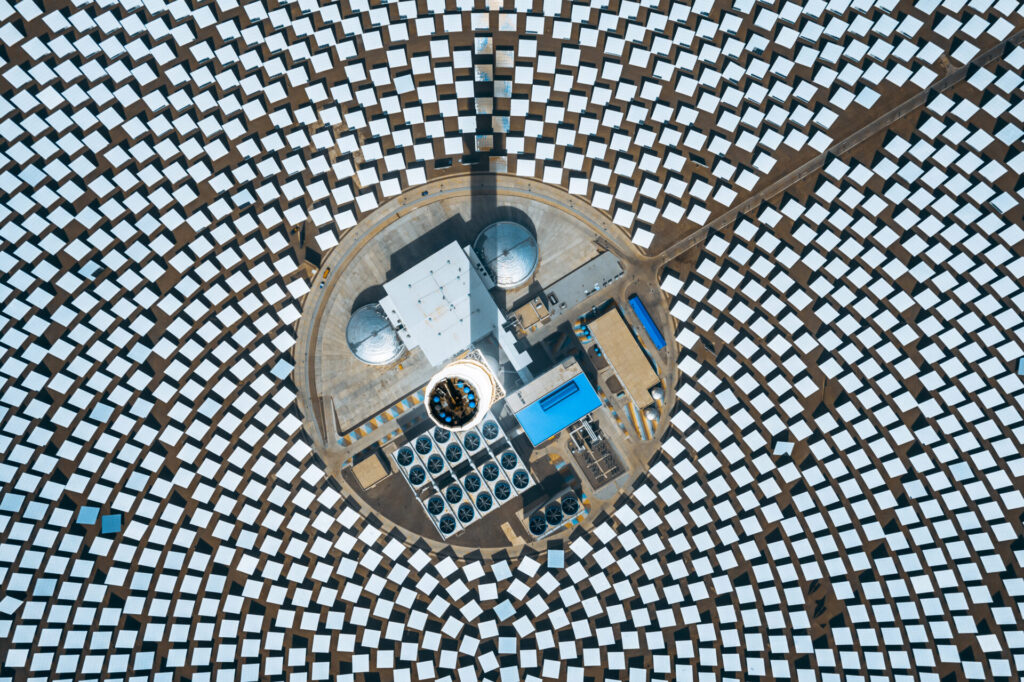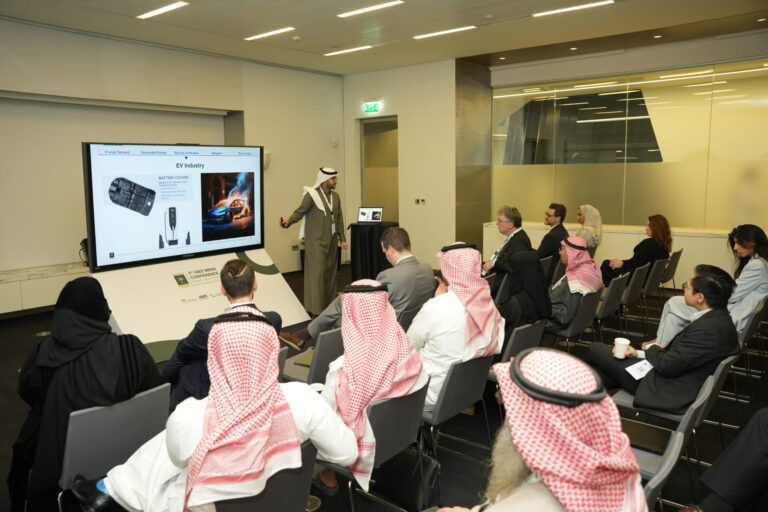A new study by the King Abdullah Petroleum Studies and Research Center (KAPSARC) maps out a trajectory to transform Saudi Arabia’s electricity sector in line with the Kingdom’s pledge to switch to renewables and reduce its reliance on fossil fuels1.
The effort is part of Saudi Arabia’s Vision 2030—a government diversification program and roadmap that aims to transform Saudi’s economy and reduce the Kingdom’s carbon footprint. In 2021, the government pledged more than $180 billion to reach net-zero emissions by 20602.
A critical component of this vision is decarbonizing the power system. “The electricity sector has to be the first sector to decarbonize. It is the lowest-hanging fruit for the Kingdom [and] the easiest emissions to remove from the economy,” says Puneet Kamboj, the study’s first author and a lead at KAPSARC’s Climate and Sustainability department.
The Saudi government aims to reach 50% renewable energy capacity by 2030 by decommissioning liquid fuel power plants and transitioning to a mix of renewable energy and natural gas. However, this transition requires significant investments to upgrade the electric grid infrastructure, and address the intermittency of renewable energy sources as well as issues related to energy storage and grid stability.
“The electricity sector has to be the first sector to decarbonize. It is the lowest-hanging fruit for the Kingdom [and] the easiest emissions to remove from the economy.”
Kamboj and his colleagues drew up a net-zero-emissions scenario for scaling up electricity generation requirements and grid capacity during the next few decades, “purely from an economic perspective,” as Kamboj describes it, considering capital investment as well as fuel, operational and maintenance costs. The researchers break down the possible long-term implications for Saudi’s electricity sector in trying to reach net zero while adjusting to rising demand for electricity as the country electrifies various sectors.
“We are trying to establish what hitting net zero by 2060 would entail,” explains co-author Mohamad Hejazi, executive director for the Climate and Sustainability department at KAPSARC and the lead for the KAPSARC Climate Adaptation and Mitigation Partnership (CAMP) project.
The current state of Saudi Arabia’s electricity sector
Saudi Arabia’s electricity sector is one of the largest in the Middle East, with an installed capacity of approximately 94 gigawatts (GW) in 2023—more than half of which has been installed in the last decade.
In the past, natural gas and crude and heavy fuel oil were the predominant sources for electricity generation in the Kingdom.
In recent years, there has been a significant shift toward natural gas, which accounted for 57% of electricity generation in 2019, up from 34% in 2010.The reliance on fossil fuels may come with its own challenges, with nearly half of Saudi Arabia’s CO2 emissions in 2022 coming from electricity generation.

A drone point view of solar and thermal panels: Saudi Arabia’s massive renewable energy push could influence the energy strategies of its neighbors. Image credit: Getty Images
In 2021, Saudi Arabia set a target of reducing 278 metric tonnes of greenhouse gas (GHG) emissions by 2030.
Shihab Elborai, an energy and sustainability expert focused on the Middle East and North Africa, explains that the transition to renewables needs to come gradually. “The first step is to phase out the use of crude oil in power generation and replace it with gas,” he says. “The surest way to derail the transition is to do so rapidly while undermining the current global energy system. You should not saw the branch while sitting on it.”
The course to decarbonization
Researchers considered four scenarios to capture the long-term impacts of different policies and mitigation efforts on Saudi Arabia’s electricity system, with growth in both the economy and population taken into account since both incur higher energy demands.
The four scenarios include varying degrees of renewable energy deployment, energy upgrades, and carbon pricing mechanisms.
The spectrum ranges from a no-policy scenario where no climate reforms or mitigation takes place to an aspirational economy-wide net-zero scenario where energy capacity from renewables is dramatically scaled up from 120GW in 2030 to a projected 600GW by 2060. The latter would require increasing annual rates of renewable power generation from 6GW to 16GW per year.
Around 11.4GW of renewable capacity is already under construction and is expected to be connected to the national grid soon.
The model includes greenhouse gas (GHG) emissions in all four scenarios. It also highlights the required capital needed. For instance, an expansion of renewable power grids, and in turn capacity, would require a whopping $500 billion investment to add new capacities from 2030 to 2060.
In the net-zero 2060 scenario that the study presents, carbon dioxide removal (CDR) technologies are highlighted as crucial in achieving net zero GHG emissions.
The KAPSARC model cites carbon capture and storage (CCS) and direct air capture (DAC) as the main technologies for capturing CO2, either from the emission sources or the atmosphere—all energy-intensive operations.
One of the study’s key findings is that achieving net-zero GHG emissions by 2060 will require a significant increase in the deployment of renewable energy technologies as energy requirements would double on the road to decarbonizing different sectors.
The integration of CCS technologies within natural gas power plants will be essential for reducing emissions.
However, these technologies require substantial energy for capturing, compressing, transporting and storing CO2. This in turn increases the overall electricity demand and may necessitate additional power-generation capacity. DAC, which uses chemical processes to capture CO2 directly from the ambient air, is a similarly electricity-intensive option.
It is why the researchers say that this level of deployment may not be the most optimal or cost-effective approach. They suggest exploring alternative pathways that focus more on reducing residual emissions rather than relying heavily on carbon removal technologies.
Renewables: Challenges and opportunities

Energy investment in emerging markets and developing economies, 2019 and 2022
While renewable energy is expected to play a pivotal role in Saudi Arabia’s transition to a sustainable electricity sector, solar power in particular has potential due to the Kingdom’s abundant sunlight and other favorable geographical conditions. Several large-scale solar projects are already in various stages of development.
Wind power is another promising renewable energy source for Saudi Arabia. The Red Sea coast, with its high wind speeds, offers ideal conditions for wind farm development.
Harnessing these renewable resources is crucial, but not without challenges. According to Kamboj, the grid would need to be adaptable to the fluctuating energy supply to ensure a reliable and resilient system. “You need to have other sources of fuel that can balance that up and down in the renewable energy generation,” he adds.
Advances in battery technology and grid management systems are also essential for storing excess energy and using it when supply is low.
Saudi Arabia seems to compare favorably with other oil-dependent nations in the Gulf region in terms of plans to cut emissions. Its massive renewable energy push may very well influence the energy strategies of its neighbors, some energy experts argue.3
Elborai explains that the sudden switch to renewables overnight may not be realistic, and emphasizes instead the need for a more gradual approach that invests in both conventional sources as well as renewables that will gradually reduce dependence on oil, moderate oil price volatility, and reshape supply-demand dynamics while maintaining energy security.
Reference
1. Kamboj, P.; Hejazi, M.; Alhadrami, K.; Qui, Y.; Kyle, P and Iyer, G., Saudi Arabia Net Zero GHG Emissions by 2060: Transformation of the Electricity Sector. KAPSARC (2023). | Article
2. https://www.bbc.com/news/world-middle-east-58955584 | Article
3. https://www.energypolicy.columbia.edu/robin-mills | Article




